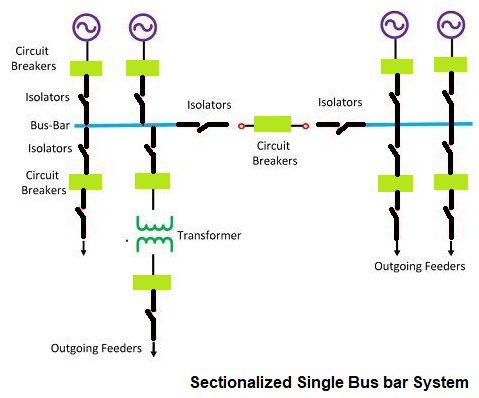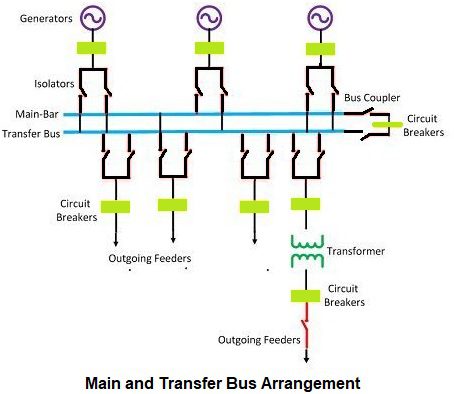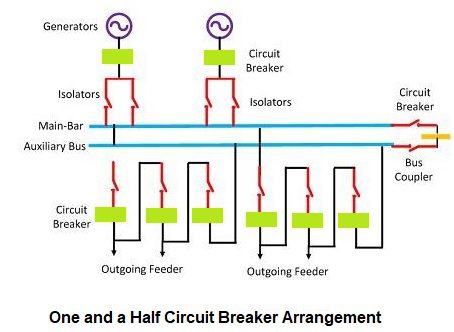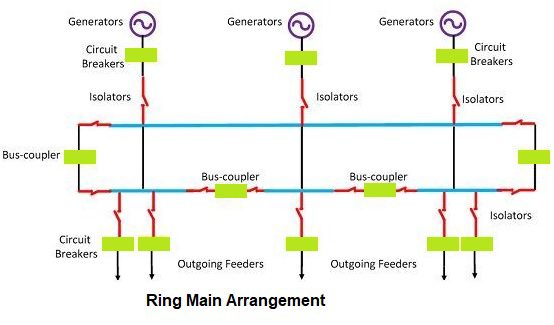Table of Contents
Definition: An electrical busbar is defined as a conductor or group of conductors used to collect electrical power from incoming feeders and distribute them to outgoing feeders. In other words, it is a kind of electrical junction in which all the incoming and outgoing electric current meet. Thus, the electrical bus bar collects electrical power at one location.
The bus bar system consists of isolators and circuit breakers. In the event of a fault, the circuit breaker closes and the faulty section of the busbar is easily disconnected from the circuit.
Electrical bus bar is available in rectangular, cross-sectional, round and many other shapes. Rectangular bus bars are mostly used in power systems. Copper and aluminum are used to manufacture electrical bus bars.
There are different types of busbar arrangements used in power systems. The selection of bus bar depends on various factors like reliability, flexibility, cost etc. The following electrical considerations govern the selection of any one particular arrangement.
- The bus bar arrangement is simple and easy to maintain.
- Maintenance of the systems did not affect their continuity.
- Installation of bus bars is inexpensive.
Smaller substations where continuity of supply is not essential use a single bus bar. But in a large substation, additional busbars are used in the system so that their supply is not interrupted. Different types of electrical busbar arrangements are shown in the figure below.
Bus bar in instrumentation
Busbar are used to provide supply to different panels in instrumentation. In instrumentation, first of all the power supply comes from the electrical department on a bus bar. After this, the power supply goes from the bus bar to the bus bar of the different panels, from where the power goes to the different instruments via TB.
Types of bus bars
Important bus-bar arrangements are discussed in this article. Based on the construction of the bus bar, they are divided as follows.
- Single bus-bar system.
- Double bus-bar system.
- Ring bus-bar system.
Single Bus-Bar Arrangement
The arrangement of this type of system is very simple and easy. There is only one bus bar with a switch in the system. All the equipments of the substation like transformers, generators, feeders are connected to this bus bar. The advantages of single bus bar arrangement are

Advantage of Single Bus-Bar Arrangement
- Its initial cost is low.
- it requires little maintenance.
- it is simple to operate.
Disadvantage of Single Bus-Bar Arrangement
- The only disadvantage of this type of arrangement is that in the event of a fault, the entire supply is interrupted.
- The arrangement provides less flexibility and is therefore used in smaller substations where continuity of supply is not essential.
Single Bus-Bar Arrangement with Bus Sectionalized
Circuit breakers and isolating switches are used in this type of busbar arrangement. The isolator disconnects the faulty section of the busbar, hence protecting the system from complete shutdown. This type of arrangement uses an additional circuit breaker which does not add much to the cost of the system.





Advantage of single Bus-bar Arrangement with Bus Sectionalization
Following are the advantages of sectional bus bar.
- The faulty section is removed without affecting the continuity of supply.
- Maintenance of individual sections can be done without disturbing the system supply.
- The system has a current limiting reactor which minimizes the occurrence of faults.
Disadvantages of Single Bus-Bar Arrangement with Sectionalization
- The system uses additional circuit breakers and isolators which increase the cost of the system.
Main and Transfer Bus Arrangement
This type of arrangement uses two types of busbars, the main busbar and the auxiliary busbar. Busbar arrangements use bus couplers that connect isolating switches and circuit breakers to the busbar. Bus couplers are also used to transfer the load from one bus to another in case of overloading. Following are the steps to transfer the load from one bus to another bus.
- By closing the bus coupler the potential of both the bus bars remains the same.
- The bus bar on which the load is transferred is kept closed.
- Open the main bus bar.
Thus, the load is transferred from the main bus to the reserve bus.





Advantages of Main and Transfer Bus Arrangement
- Continuity of supply is maintained even in case of fault. In case of fault in any bus, the entire load is shifted to another bus.
- Repairs and maintenance can be easily performed on busbars without disturbing their continuity.
- The maintenance cost of the system is less.
- The bus potential is used for operating the relay.
- The load can be easily shifted to any bus.
Disadvantages of Main and Transfer Bus Arrangement
- In this type of arrangement two bus bars are used which increases the cost of the system.
- Fault on any bus will cause complete shutdown of the entire substation.
Double Bus Double Breaker Arrangement
This type of arrangement requires two bus bars and two circuit breakers. It does not require any additional equipment such as bus couplers and switches.





Advantages of Double Bus Double Breaker
- This type of arrangement provides maximum reliability and flexibility in supply. Because their continuity will not be disturbed by fault and maintenance.
- The continuity of supply remains the same as load can be transferred from one bus to another in case of fault.
Disadvantages of double bus Double breaker
- In this type of arrangement two buses and two circuit breakers are used which increases the cost of the system.
- Their maintenance cost is very high.
- Due to its high cost, this type of bus-bar is rarely used in substations.
Sectionalized Double Bus Bar Arrangement.
In this type of bus arrangement, sectional main bus bars are used along with auxiliary bus bars. Any part of the busbar that is removed from the circuit for maintenance and that is connected to any auxiliary bus bar. But such an arrangement increases the cost of the arrangement. Splicing of auxiliary bus bars is not required as this would increase the cost of the system.





One and a Half Breaker Arrangement
In this arrangement three circuit breakers are required for two circuits. Each circuit of the bus bar uses one and a half circuit breakers. This type of arrangement is preferred in large stations where power consumption per circuit is large.





Advantages of One and a Half Breaker Arrangement
- It protects the system against loss of supply.
- The potential of the bus bar is used for operation of the relay.
- In this type of arrangement additional circuits are easily added to the system.
Disadvantages of One and a Half Breaker Arrangement
- The circuit gets complicated because of the relaying system.
- Their maintenance cost is very high.
Ring Main Arrangement
In this type of arrangement, the end of the bus bar is connected to the starting point of the bus to form a ring.





Advantages of Ring Main Arrangement
- This type of arrangement would provide two routes for supply. Thus the defect will not affect his work.
- The fault is localized to the particular section. Hence the complete circuit is not affected by the fault.
- In this type bus bar a circuit breaker can be maintained without interrupting the supply.
Disadvantages of Ring Main Arrangement
- Having a problem with the new circuit.
- If any circuit breaker is opened then overloading occurs on the system.
Read Also
- Control Wiring | Control Panel Wiring | Star Delta Power Wiring | Power wiring
- What is NMR Spectroscopy?
- MCQ on spectroscopic techniques